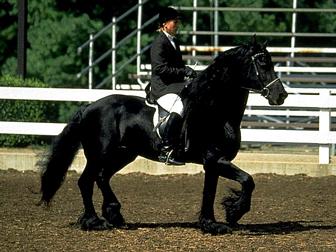
OVERVIEW
The Friesian breed is one of the oldest domesticated breeds in Europe. It is native to the province of Friesland in the northern Netherlands. The Friesian suffered a decline in numbers with the increase of mechanization on the farm and in transportation. In fact, the number of Friesian stallions reputedly was reduced to only three prior to World War I. The breed was rejuvenated by introducing Oldenburg blood. In recent years the breed has attracted a great deal of acclaim and its future seems assured. The Friesian is used for light agricultural work. It is traditionally used in harness to quaint Friesian gigs. The Friesian is also found in circuses and in driving competitions.
PHYSICAL DESCRIPTION
One of the outstanding characteristics of the Friesian horse is its very long mane and tail. These are never cut and reach the ground. The breed also has abundant feather and long leg hair reaching from the middle of the leg. The color is always black, and only a white star in the forehead is permissible. The head of the Friesian is carried quite high and the face is expressive. The neck is carried rather vertically and is low-set. The legs and quarters are muscular yet smooth. It stands at 15 hands and has an excellent disposition.
ORIGIN
The Friesian is an old breed of horse dating from the Middle Ages. Its location of origin is Friesland in the northern Netherlands. The breed nearly died out before World War I and has since been revived as a fine carriage horse. The horse is now being exported to other countries and its popularity is growing.
INTERESTING FACTS
It would be difficult to date the origin of the Friesian horse with precision. It is certain that the horse was well-known in the Middle Ages since it is found in art work of that period. In the 1600s it was adopted to carry heavy weight under saddle. Later, due to its splendid action at the trot, the Friesian was bred to be lighter in weight. This, unfortunately, limited its use in agriculture and led to its decline in the early 1900s. Systematic breeding has restored the breed's quality and its numbers are now increasing.
INFLUENCES
1. Friesland Stock
2. Andalusian
3. Arab
4. Barb
5. Oldenburg
For more information:
The Friesian Horse Association of North America
Listed as "Watch" by The American Livestock Breeds Conservancy (2004)